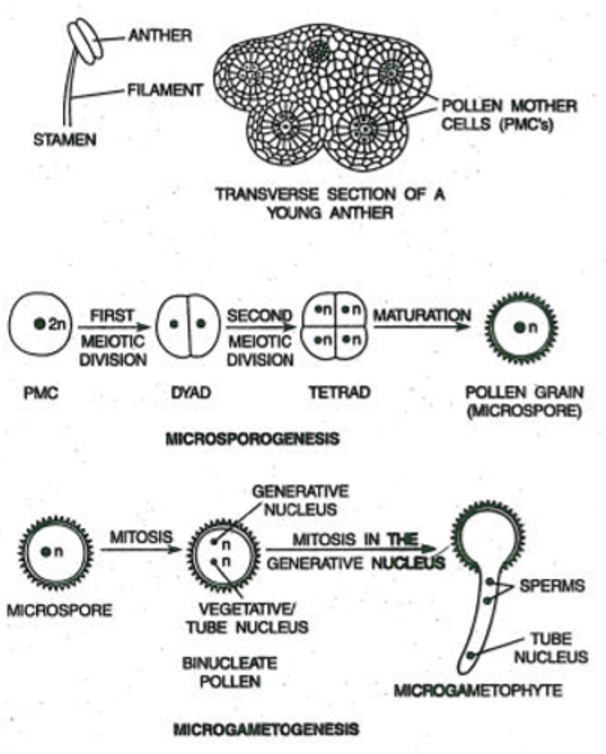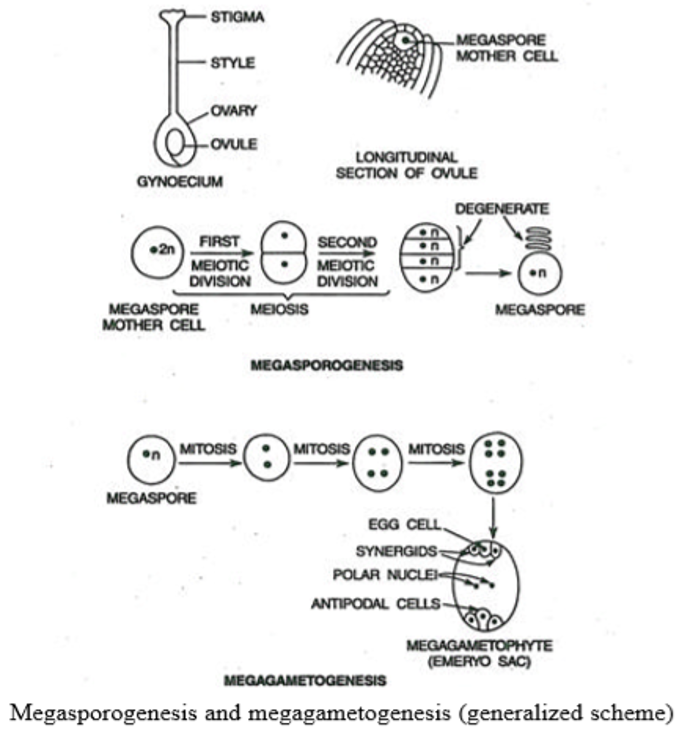🦚 Types
Asexual and Sexual Reproduction
- Mode of reproduction determines the genetic constitution of crop plants, that is, whether the plants are normally homozygous or heterozygous. This, in turn, determines the goal of a breeding programme.
- The modes of reproduction in crop plants may be broadly grouped into two categories, asexual and sexual.
Asexual Reproduction
- A sexual reproduction does not involve fusion of male and female gametes.
- New plants may develop from vegetative parts of the plant (vegetative reproduction) or may arise from embryos that develop without fertilization (apomixis).
Vegetative Reproduction
- In nature, a new plant develops from a portion of the plant body.
- This may occur through modified underground and sub-aerial stems, and through bulbills.
Underground Stems
- The underground modifications of stem generally serve as storage organs and contain many buds.
- These buds develop into shoots and produce plants after rooting.
- Examples:
- Tuber: Potato
- Bulb: Onion, Garlic
- Rhizome: Ginger, Turmeric
- Corm: Bunda, Arwi
Sub-aerial Stems
- These modifications include
runner,stolon,suckeretc. - Sub-aerial stems are used for the propagation of mint, date plam etc.
Bulbils
- Bulbils are modified flowers that develop into plants directly without formation of seeds.
- These are vegetative bodies; their development does not involve fertilization and seed formation.
- The lower flowers in the inflorescence of garlic naturally develop into bulbils.
- Scientists are trying to induce bulbil development in plantation crops by culturing young inflorescence on tissue culture media; it has been successfully done in the case of cardamom.
Artificial Vegetative Reproduction
- It is commonly used for the propagation of many crop species, although it may not occur naturally in those species.
- Stem cuttings are commercially used for the propagation of sugarcane, grapes, roses, etc. Layering, budding, grafting and gootee are in common use for the propagation of fruit trees and ornamental shrubs. Techniques are available for vegetative multiplication through tissue culture in case of many plant species, and attempts are being made to develop the techniques for many others. In many of these species sexual reproduction occurs naturally but for certain reasons vegetative reproduction is more desirable.
Significance of Vegetative Reproduction
- Vegetative reproducing species offer unique possibilities in breeding. A desirable plant may be used as a variety directly regardless of whether it is homozygous or heterozygous.
- Further, mutant buds, branches or seedlings, if desirable, can be multiplied and directly used as varieties.
Apomixis
- In apomixis, seeds are formed but the embryos develop without fertilization. Consequently, the plants resulting from them are identical in genotype to the parent plant.
- In apomictic species, sexual reproduction is either suppressed or absent.
- When sexual reproduction does occur, the apomixis is termed as facultative.
- But when sexual reproduction is absent, it is referred to as obligate.
- Facultative apomixis is more common.
- When embryo arises from haploid cells, apomixis is non-recurrent because its progeny can’t be maintained further and when embryo arises from diploid cells, apomixis is called recurrent.
- Apomixis is synonym of
agamospermy. - Apomixis is of two types:
- Adventitious embryony: Embryo is developed directly from vegetative cells of ovule such as nucellus, integument & chalaza. No production of embryo sac. e.g. Nucellar seedlings in mango, citrus, orchids etc.
- Gametophytic apomixis: Embryo developed from egg cells or other cells of embryo sacs but without fertilization.
Apomeiosis
- In recurrent apomixis, unreduced embryo sacs are developed by a process of apomeiosis.
Apospory
- Unreduced embryo sacs are developed from some vegetative cells of ovule through a series of mitotic divisions and without meiosis.
- E.g. some species of Hieraceum Malus, Crepes, Ranuculus, Orchids etc.
Apogamy
- In apogamy,
synergidsorantipodal cellsdevelop into an embryo. - Like parthenogenesis, apogamy may be haploid or diploid depending upon the haploid or diploid state of the embryo sac.
- Diploid apogamy occurs in Antennaria, Alchemilla, Allium and many other plant species.
Diplospory
- Embryo sac is produced from the
mega sporewhich may be haploid or more generally, diploid. - In apomictic species, diploid megaspores are produced by modified meiosis. The embryos in such embryo sacs may be arised by either parthenogenesis or pseudogamy.
Parthenogenesis
- Embryo is developed from the embryo sac without pollination. Pollination is the landing of pollen onto the stigma of a flower.
- [Parthenocarpy means development of fruit without fertilization]
- Parthenogenesis is of two types:
- Gonial parthenogenesis: Embryo is developed from egg cell.
- Somatic parthenogenesis: Embryo is developed from some cells of the embryo sac other than the egg cell.
- Generally, ‘Parthenogenesis’ is used as a synonym of somatic parthenogenesis.
Pseudogamy
- Pseudo means false & gamous means marriage. Pollination occurs but fertilization of egg cell does not take place however fertilization of secondary nucleus occurs.
- Pseudogamy is of two types:
- Gonal pseudogamy: Embryo is developed from egg cell.
- Somatic pseudogamy: Embryo is developed from some other cells of embryo sac.
Vybrid

- It is a progeny obtained from a cross between two facultative apomicts.
- The vybrid itself reproduces through facultative apomixis and is maintained by harvesting the seeds of only F1 like apomictic plants in every generation.
Significance of Apomixis
- Apomixis is a nuisance when the breeder desires to obtain sexual progeny, i.e., selfs or hybrids.
- But it is of great help when the breeder desires to maintain varieties.
- Thus in breeding of apomictic species, the breeder has to avoid apomictic progeny when he is making crosses or producing inbred lines. But once a desirable genotype has been selected, it can be multiplied and maintained through apomictic progeny.
- This would keep the genotype of a variety intact.
- Asexually reproducing crop species are highly heterozygous and show severe inbreeding depression.
- Therefore, breeding methods in such species must avoid inbreeding.
Sexual Reproduction
- Sexual reproduction involves fusion of male and female gametes to form a zygote, which develops into an embryo.
- In crop plants, male and female gametes are produced in specialised structures known as flowers.
Flower
- Hermaphrodite/Perfect Flower: Such flower contains both stamens (♂) and Pistil (♀).
- Staminate Flower: Such flower contains
only stamensnot pistil. - Pistillate Flower: Such flower contains
only pistil& not stamen. - Monoecious Plant: Here staminate & Pistillate flowers occur on the same plant. E.g.
Maize,Coconut,Castor,Colocasiaetc. - Dioecious Plant: Here staminate & pistillate flowers occur on different plants E.g.
Papaya,Date palm,Pistachioetc. - Anthesis: In the process of Flowering, the first opening of a flower is called anthesis. It facilitates the pollination by opening of flower.
Sporogenesis
- In crop plants, meiotic division of specific cells in stamen and pistil yields microspores and megaspores, respectively.
- This is followed by mitotic division of the spore nuclei to produce gametes; the male and female gametes are produced in microspores and megaspores, respectively.
- Productions of microspores and megaspores is known as sporogenesis.
- Microspores are produced in anthers (microsporogenesis), while megs-spores are produced in ovules (megasporogenesis).
Microsporogenesis
- Each anther has four pollen sacs, which contain numerous pollen mother cells (PMCs).
- Each PMC undergoes meiosis to produce four haploid cells or microspores.
- This process is known as microsporogenesis.
- The microspores mature into pollen grains mainly by a thickening of their walls.
Megasporogenesis
- Megasporogenesis occurs in ovules, which are present inside the ovary.
- A single cell in each ovule differentiates into a megaspore mother cell.
- The megaspore mother cell undergoes meiosis to produce four haploid megaspores.
- Three of the megaspores degenerate leaving one functional megaspore per ovule. This completes megasporogenesis.
Gametogenesis
- The production of male and female gametes in the microspores and the megaspores, respectively, is known as gametogenesis.
Microgametogenesis

- This refers to the production of male gamete or sperm.
- During the maturation of pollen, the microspore nucleus divides mitotically to produce a generative and a vegetative or tube nucleus.
- The pollen is generally released in this binucleate stage.
- When the pollen lands onto the stigma of a flower, it is known as pollination.
- Shortly after pollination, the pollen germinates. The pollen tube enters the stigma and grows through the style. The generative nucleus now undergoes a mitotic division to produce two male gametes or sperms.
- The pollen, along with the pollen tube, is known as microgametophyte.
- The pollen tube finally enters the ovule through a small pore, micropyle, and discharges the two sperms into the embryo sac.
Megagametogenesis

- The nucleus of a functional megaspore divides mitotically to produce four or more nuclei. The exact number of nuclei and their arrangement vary considerably from one species to another.
- In most of the crop plants, megaspore nucleus undergoes three mitotic divisions to produce eight nuclei. Three of these nuclei move to one pole and produce a central egg cell and two synergid cells; one synergid is situated on either side of the egg cell. Another three nuclei migrate to the opposite pole to give rise to antipodal cells. The two nuclei remaining in the centre, the polar nuclei, fuse to form a secondary nucleus.
- The megaspore thus develops into a mature megagametophyte or embryo sac.
- The development of embryo sac from a megaspore is known as megagametogenesis.
- The embryo sac generally contains one egg cell, two synergids, three antipodal cells (all haploid), and one diploid secondary nucleus.
Significance of Sexual Reproduction
- Sexual reproduction makes it possible to combine genes from two parents into a single hybrid plant.
- Recombination of these genes produces a large number of genotypes.
- This is an essential step in creating variation through hybridization.
- Almost the entire plant breeding is based on sexual reproduction.
- Even in asexually reproducing species, sexual reproduction, if it occurs, is used to advantage, E.g., in sugarcane, potato, sweet potato etc.
- Mode of reproduction determines the genetic constitution of crop plants, that is, whether the plants are normally homozygous or heterozygous. This, in turn, determines the goal of a breeding programme.
- The modes of reproduction in crop plants may be broadly grouped into two categories, asexual and sexual.
Asexual Reproduction
- A sexual reproduction does not involve fusion of male and female gametes.
- New plants may develop from vegetative parts of the plant (vegetative reproduction) or may arise from embryos that develop without fertilization (apomixis).
Vegetative Reproduction
- In nature, a new plant develops from a portion of the plant body.
- This may occur through modified underground and sub-aerial stems, and through bulbills.
Underground Stems
- The underground modifications of stem …
Become Successful With AgriDots
Learn the essential skills for getting a seat in the Exam with
🦄 You are a pro member!
Only use this page if purchasing a gift or enterprise account
Plan
₹
- Unlimited access to PRO courses
- Quizzes with hand-picked meme prizes
- Invite to private Discord chat
- Free Sticker emailed
Lifetime
₹
9,999
once
- All PRO-tier benefits
- Single payment, lifetime access
- 4,200 bonus xp points
- Next Level
T-shirt shipped worldwide

Yo! You just found a 20% discount using 👉 EASTEREGG

High-quality fitted cotton shirt produced by Next Level Apparel